Milky Way photography has grown steadily in popularity in recent years. It used to be that crowded landscape photo locations would be deserted once the last light of sunset faded away. Now, photographers stay out late into the night, and I find that my chances of bumping into someone at 2 a.m. in a dark, secluded spot are much higher than they used to be. Getting the Milky Way to show up on the back of your camera’s LCD isn’t difficult once you learn the proper exposure. To get a clean, high-quality shot, however, the lens you choose will make a big difference. If you want to learn more about Milky Way photography before choosing a lens, check out my in-depths guides on planning, shooting, and editing Milky Way photos.
Important Factors When Choosing a Lens for Milky Way Photography
There are several factors to keep in mind when choosing a lens for Milky Way photography. Your ultimate lens choice will be a compromise after you determine which of these factors are the most important to you. Some of those compromises will come down to the versatility of the lens and your artistic vision, while others will absolutely involve your bank account.
Focal Length
The focal length of the lens you chose for Milky Way photography will determine both the field of view of your image (and, as a result, how much of the Milky Way you can fit in your frame) and how long of a shutter speed you can choose before star trailing is obvious (meaning that the stars in your image seem to be elongated instead of pinpoints). I have used focal lengths ranging from 14mm to 50mm on a full-frame camera when shooting Milky Way photography, and I have plans to go as wide as 11mm and potentially as narrow as 100mm or more on full-frame.
Aperture
Aperture is another fundamental factor to keep in mind when choosing a lens for your Milky Way photography. The wider the aperture of a lens, the more light that can be gathered for your exposure. A wide aperture lens means that you can get away with shorter shutter speeds and lower ISO settings than with other comparable lenses. For example, if you shoot at 24mm with an aperture of f/2.8 and ISO 6400 for 20 seconds, that means that shooting at 24mm with an aperture of f/1.4 would allow you to lower your ISO to 3200 and shutter speed to 10 seconds while still getting the same overall brightness of your exposure. The downside to wider aperture lenses is the cost, size, and weight, which can be a burden on your bank account and also your body parts with the weight added to your camera setup.
Lens Aberrations
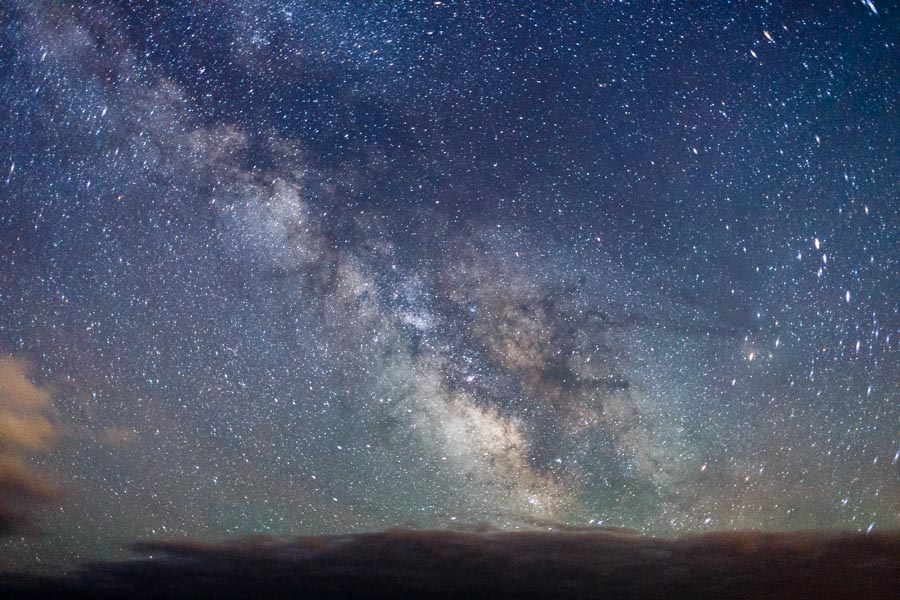
When a lens which may be used for astrophotography is discussed, you will often hear mention of “coma” produced by the lens, which has become sort of a catch-all word for imperfections in the ability of a lens to focus a point of light. Aberrations can involve splitting light into its separate color wavelengths (chromatic aberrations), making the stars in your image look like they have a fuzzy tail extending in one direction like a comet (comatic aberrations, aka “coma”), making the stars in your image look like they have sprouted butterfly wings parallel to the edges of your frame (sagittal astigmatism), and more. If a lens exhibits these imperfections (and most do, just to differing degrees), they are often most apparent at wider apertures. During the daytime when there is plenty of available light, that means the photographer can choose a smaller aperture to avoid these issues. However, in astrophotography when every bit of faint starlight must be gathered, issues at those wide apertures are much more apparent.
Lens aberrations are correctable in post-processing, although some take far more effort than others. I won’t ignore a lens that has some minor issues with aberrations in the corners. However, if 50% of the stars in my image have obvious “wing tips” on either side of them, trying to correct the issue in Photoshop later is going to be potentially painstaking and more effort than I think it is worth. As a result, I try to find a lens with minimal, although not necessarily non-existent issues with aberrations.
With that said, every lens you use for Milky Way photography is going to involve you making some sort of concession, whether it be in cost, weight, quality, maximum aperture, or focal length. It will be up to you to decide what is most important to the Milky Way photos you would like to take, and which lens(es) best fit your situation.
Now that we have all of that out of the way, here are some great choices to consider. However, keep in mind that these in no way make up a comprehensive list. There is a heck of a lot of lenses out there, some of which will be able to get a nice Milky Way photo pop up on the back of your camera’s LCD. Based on the information above, choose another lens not on the list that might fit the bill and let us know how it does. Without further ado, to the lenses!
The Ultra-Wide Zoom Lenses
Tamron 15-30mm f/2.8
The Tamron 15-30mm f/2.8 lens is a beast of an ultra-wide zoom lens, both in performance and in size. Having this lens will add almost 2.5 pounds to your setup, but with that comes versatility, very solid build quality, and great results. The focal range it provides is perfect for several different types of Milky Way shots and the sharpness of the lens is fantastic. Combine that with almost non-existent coma and sagittal astigmatism, and the Tamron 15-30mm is a Milky Way powerhouse.
While the Tamron 15-30mm is versatile and can be used for general landscape and events (it also has vibration control) in addition to astrophotography, it may be more lens than you need if you are strictly looking for an ultra-wide lens capable of shooting the Milky Way, especially when you consider that the price is around double what you might pay for an ultra-wide prime lens capable of capturing a similar photo. With that said, if you have a new Tamron 15-30mm attached to your camera under a clear night sky, you won’t be disappointed.
The Tamron 15-30mm is available in Canon EF, Nikon FX, and Sony A mount.
Nikon 14-24mm f/2.8
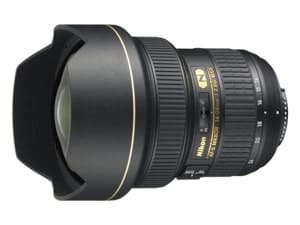
A big advantage that the Nikon 14-24mm has over competitors like the Tamron 15-30mm is the extra 1mm of focal length on the wide end, which amounts to an extra few degrees to use when framing your composition. Due to the added cost, however, I personally view the Tamron 15-30mm as the better buy unless that extra 1mm of wide-angle view is truly worth it to you.
Canon 16-35mm f/2.8

Tokina 11-16mm f/2.8
The Tokina 11-16mm f/2.8 is the ultra-wide zoom I have seen used most often for APS-C size camera sensors, and for good reason. The lens has good sharpness throughout its focal range, and limits coma and sagittal astigmatism well, even at the corners of the frame. The lens does have some noticeable chromatic aberration issues. However, of all weak points a lens could have, this is one that is fairly easy to correct in post-processing.
Ultra-Wide Prime Lenses
Irix 15mm f/2.4
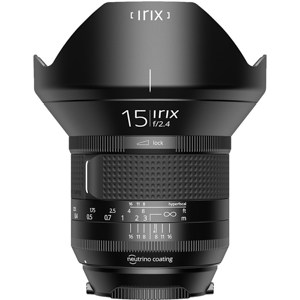
The Irix 15mm comes in two versions that are optically the same (“Firefly” and “Blackstone”), but vary slightly in barrel design. Both versions are very sharp, have minimal astigmatism, and are solidly built, but cost a fraction of what a lens like the ultra-wide zooms listed above does. At the time of this writing, the Firefly version of the lens costs $400 and the Blackstone costs $600, less than half the cost of a lens like the Tamron 15-30mm. As an added bonus, the lens also accepts 95mm screw-on front filters, making it enticing as a daytime lens, and also making the only lens I’m aware of at that wide of a focal length that does not require an expensive filter system.
The Irix 15mm f/2.4 is available in Canon, Nikon, and Pentax mounts.
Nikon 20mm f/1.8
The Nikon 20mm f/1.8 is a unique lens. At 20mm, its focal length is plenty wide on a full-frame camera to capture a photo incorporating both the Milky Way and the land below. However, it also boasts a fast f/1.8 aperture, which allows you to keep your shutter speed and ISO lower than you would with an f/2.8 lens, giving you and extra 1-1/3 stop of light and, as a result, cleaner night sky photos. On the downside, however, the lens does exhibit some noticeable sagittal astigmatism at f/1.8. The astigmatism does start to diminish by f/2.5. However, if your goal is to use the fast f/1.8 aperture for night photography, you’ll either need to stop down to f/2.5 and almost negate the benefit of the lens’ maximum aperture or accept some noticeable wingtips in the corners of your image. On the upside, the lens does accept screw-on front filters, making it more versatile in case you are looking for a lens that can also double as a daytime landscape lens without the need for a separate filter holder system.
Sigma 20mm f/1.4
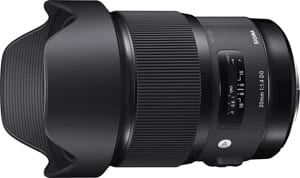
The Sigma 20mm f/1.4 is a fantastic lens with little competition, and it produces very sharp photos even at f/1.4. Unfortunately, sagittal astigmatism that makes the Nikon 20mm f/1.8 lens somewhat less enticing also plagues the Sigma 20mm f/1.4. The wing-tipped stars are very apparent in the corners of the frame at f/1.4, and are still visible when stopping down to f/2.5. However, if you’re willing to spend a little time in post-processing correcting this issue, the Sigma 20mm f/1.4 is a beast of a lens for Milky Way photography.
The Sigma 20mm f/1.4 is available in Sigma, Canon, and Nikon mounts. Like with the other Sigma lenses on this list, you’ll unfortunately need an adapter to use it on other camera systems.
Wide-Angle Zoom Lenses
Sigma 24-35mm f/2
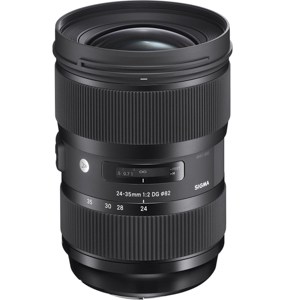
Just like with the 20mm f/1.4, the Sigma 24-35 f/2 lens comes in Sigma, Canon, and Nikon mounts.
Sigma 18-35mm f/1.8
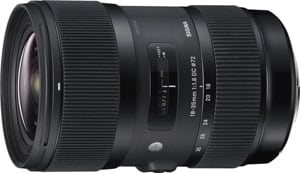
The Sigma 18-35mm is available in Sigma, Canon and Nikon mounts.
The 35mm Primes
The 35mm f/1.4 lens is a fairly common on among lens manufacturers, so I won’t try to pick and choose between all of the options here. At 35mm on a full-frame camera, the core of the Milky Way will be large and prominent in your photo, and an f/1.4 aperture will gather plenty of light for a good exposure. Among the main 35mm options, both the Canon 35mm f/1.4 and the Sigma 35mm f/1.4 are sharp and exhibit almost no coma or sagittal astigmatism. However, the Nikon 35mm f/1.4 lens shows noticeable astigmatism in the corners of the frame, meaning that Nikon Milky Way shooters should look towards Sigma’s option if a fast 35mm prime is in your sights.
The 50mm Primes
Just like with the 35mm f/1.4 lenses, 50mm primes are very common among lens manufacturers. While many of these lenses have maximum apertures of f/1.8 and can be bought fairly inexpensively, various f/1.4 and even f/1.2 options also exist. 50mm on a full-frame camera essentially fills up your composition with the core of the Milky Way, and even a single 8-second exposure under a dark sky can capture a huge amount of detail.
Given the simplicity of their construction, most 50mm lenses I have tried are sharp. However, none of the 50mm f/1.8 lenses I have tried control sagittal astigmatism very well, and the f/1.4 and f/1.2 versions of the lens are normally noticeably worse with regard to astigmatism. The exception to this rule seems to be the Sigma 50mm f/1.4, which has very minimal astigmatism, even at f/1.4. However, for the purpose of astrophotography, it may be pretty hard to justify paying the extra $700 or so for the Sigma 50mm f/1.4 over a 50mm f/1.8. In this case, I’d suggest just grabbing the 50mm prime that fits your camera system and, if astigmatism bothers you, spend a little bit of time correcting it in post-processing and save yourself $700.
A few words about Samyang lenses
Samyang Optics Company sells manual focus prime lenses under the names Rokinon, Samyang, and Bower. It would be a disservice to readers not to mention them here, but I won’t go as far as to say that I wholeheartedly recommend them. The title of this post is the “best” Milky Way lenses, and I just can’t put Samyang in that category.
If you do a search on the internet for Samyang lenses, you will usually find two main opinions: the ones that rave about the incredible sharpness of the lenses, and the ones that note the poor quality of the lenses they received and wonder what’s wrong. Based on other photographers I’ve talked with, Samyang does produce sharp lenses, but I’ve never seen one. The lenses have been plagued by issues with poor build quality and quality control, leading many of their lenses to be decentered (making one side of the frame out of focus), blurry, or unable to focus properly. And, even if you do win the lottery and get a sharp lens, treat it like your first-born child, because the glue and plastic screws that hold the lenses together can’t withstand much shaking or bumps. I personally bought the Rokinon 14mm f/2.8 as my first lens for Milky Way photography. After sending three copies back due to various sharpness and focusing issues, I eventually moved on to a different lens manufacturer. It didn’t matter to me how cheap the Rokinon lens was if it was never functional when I needed to use it.
Samyang does make several lenses ideal for Milky Way photography. The 14mm f/2.8 and 24mm f/1.4 lenses are made for full-frame sensors, while the 12mm f/2 and 16mm f/2 lenses are available for APS-C sized sensors. If cost is your number one factor when purchasing a lens for Milky Way photography, these lenses should be on your radar. However, as substitutes, the Irix 15mm f/2.4 Firefly sells for only $50 to $100 more than the Samyang 14mm f/2.8 and is much better quality, and the Sigma 24mm f/1.4 mentioned above is about $300 more expensive than its Samyang counterpart (about $850 for the Sigma and $550 for the Samyang). If you are able to scrape together the extra money you’ll gain yourself excellent build quality, autofocus, and great sharpness with the Sigma.
Samyang lenses are typically available in Canon, Nikon, and Sony mounts.
The Future
Although it has not yet been released, Sigma has a 14mm f/1.8 lens that will soon be available for full-frame cameras. As of this writing, the release date and price has not been announced, but the initial sample images look excellent for astrophotography. The lens could be a game-changer for those who are sticklers about getting the cleanest, lowest-noise image possible since there are currently no other lenses like it on the market. Keep an eye out, because, after cries to Sigma about their 20mm f/1.4 and 24mm f/1.4 lenses having issues with astigmatism wide open, this new lens seems geared towards making astrophotographers happy.


Kevin, which is the best for milky way/astrophotography/night sky, Tokina 11-16mm or Tokina 11-20mm?
I will buy Tokina lens for milky way/astrophotography/night sky, but I confused between them.
Actually Samyang and Rokinon are the same folks. I found that out while researching on the 14mm F2.8 lens which comes in both brands. I cannot remember why they are named differently.They also have another name brand not so popular.My copy of Rokinon 14mm f2.8 is sharp but I use it less and less due to the vignette issues. I consider it sharper than my Nikon 14-24mm f2.8 which cost 5x more.The Nikon however has little vignettes issues at the widest aperture.
While the quality issues aside, I have tried and own nearly all the different lenses mentioned for night sky photography. Pretty much all the wides you mentioned have really awful astigmatism in the corners, including the image you use for area coverage. The one item that sets the Rokinon/Samyang apart from their more expensive cousins is their relative lack of astigmatism. I really have not had the issues with lens centering on the two I presently own, the 14 and the 24. I did use the 12 for sometime, but I ended up excessing it as I tend to carry the Nikon 8-15 zoom more often in my bag. I would welcome the better build quality of the Irex for example, but the corners look so awful on their shots it makes the lens a non-starter. I can deal with vignetting, Photoshop has a tool for that, but smeared stars in the corners can’t be fixed.
Hi,
I was wondering if you could help me. I have just purchased a Canon 5D mk.iv after getting a great deal(-30%) and wanting to upgrade to my first full-frame sensor. My plan originally was to take landscape and astro-landscape shots whilst traveling, originally i was set on buying 2 lenses to cover both themes of shooting and my choices were:
Carl Zeiss 21mm f/2.8 Distagon for Landscape
Rokinon 24mm F/1.4 for Astro-landscape
but i am now thinking the Rokinon has too-narrow a focal length and i should get something more wide to really capture the landscape at night. Is it worth getting both lenses though? Or is there a lens that will cover both these subjects without sacrificing quality in each shooting theme or am i better off keeping the distagon and buying a astro-landscape specific lens? I want to shoot both themes but i am not sure what to buy in terms of a astro-specific lens and even more so now after hearing that many Rokinon 24mm f/1.4 are defective and get returned due to imperfections.
What are my choices in your humble opinion? I have around $2000 for 2 lenses and the majority of that was going to go towards the Distagon(know source i can get for $1100) and the remaining would be for my astro-specific lens although i may be tempted to spend more on something truly worth it . Please can you advise?
Many Thanks in advance!
John
Hi Kevin,
I am confused in buying two lenses, please help me to choose for Nikon D600
1- Brand New Nikon AF-S NIKKOR 20mm f/1.8G ED Lens in approximate 975 Canadian dollars
2- Used but in very good condition, AF Nikkor Lens 14mmf/2.8D ED in $1250 Canadian dollars
I want to use this lens for Northern Lights and Milky Way photography.
Thanks, waiting for your quick reply:)